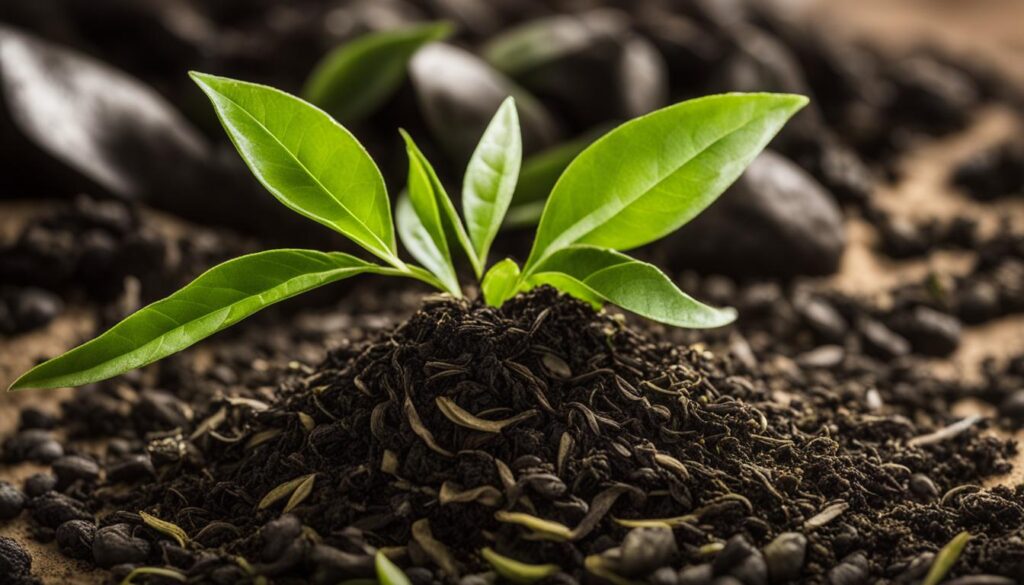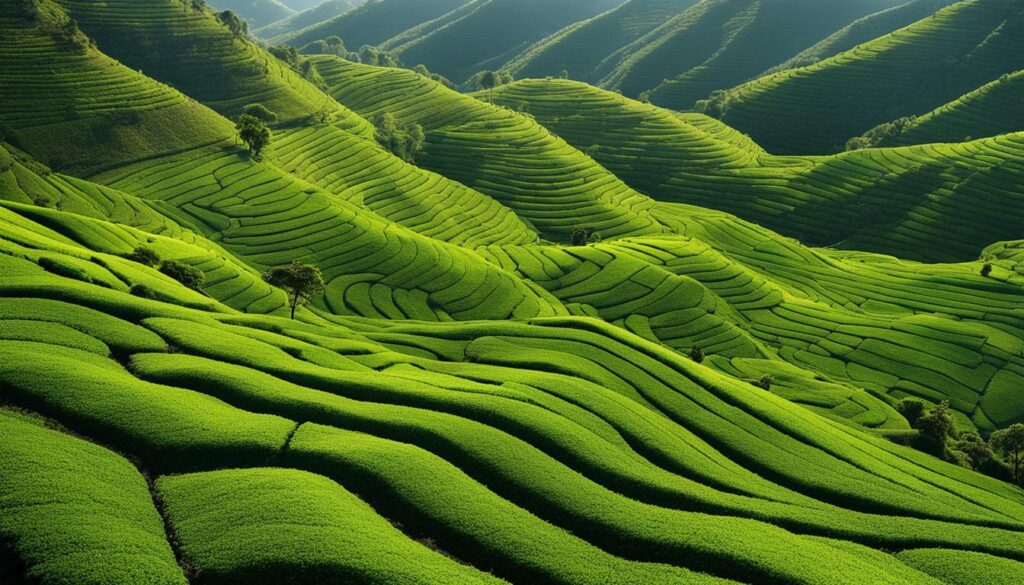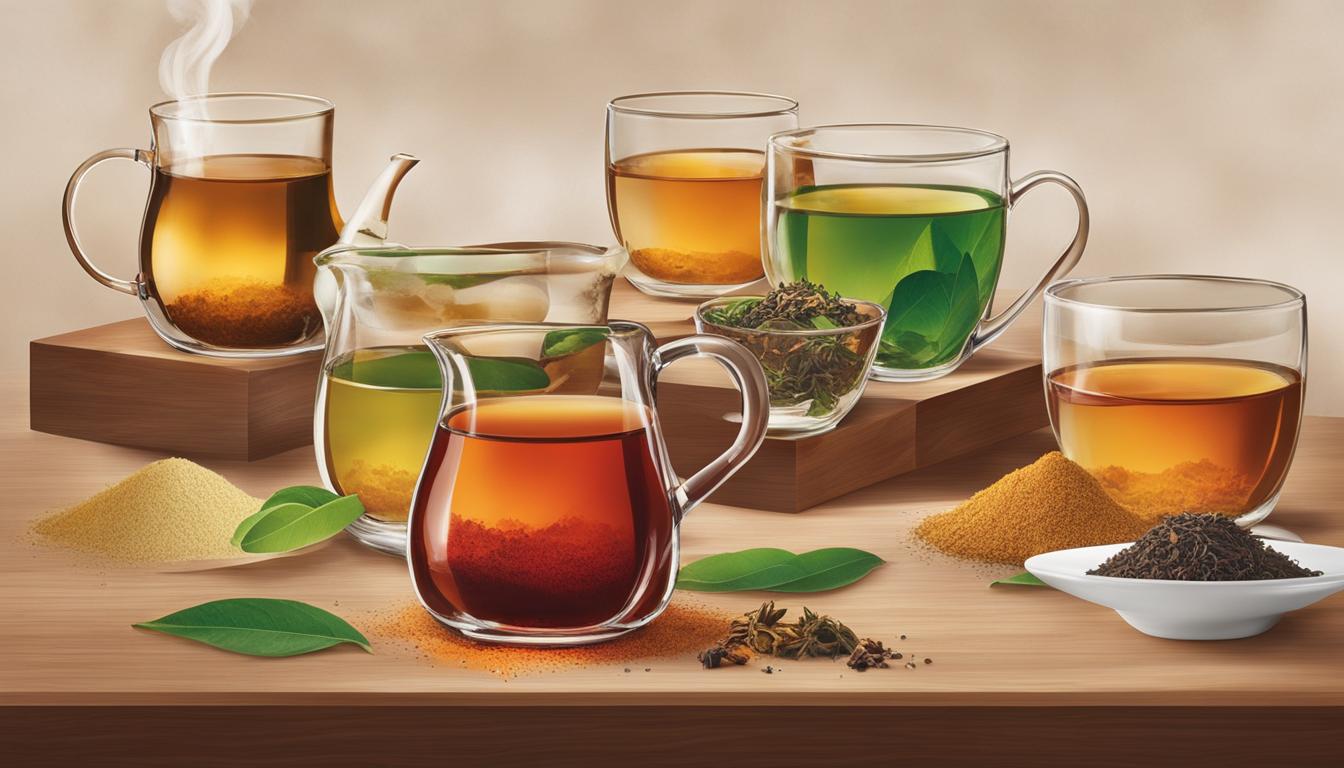Welcome to our exploration of the fascinating world of tea flavors! Today, we’ll take a closer look at how different regions impact the taste of tea. Just like in the world of wine, where the concept of terroir reigns supreme, the flavor of tea is influenced by factors beyond the plant varietal and processing techniques.
Terroir, the French term meaning “a sense of place,” encompasses a myriad of elements that shape the character of tea. From the composition and chemistry of the soil to the mineral content in the spring water, from the local ecosystem to the weather conditions, every aspect plays a role in the final cup of tea.
Imagine sipping a cup of tea and being transported to the lush tropical river valley of Assam, India, where the clay-like soil imparts a rich and full-bodied flavor to the famous Assam tea. Or picture yourself in Kenya, where volcanic soil imbues the tea with its unique and distinct characteristics.
Join us as we delve into the impact of soil, climate, and geography on tea flavor. We’ll uncover the secrets behind sweeter teas at higher elevations, explore how weather conditions affect tea leaves, and revel in the diverse flavors produced by different regions around the world.
Key Takeaways:
- Region plays a significant role in determining the flavor profiles of tea.
- The composition and chemistry of the soil influence tea taste.
- Climate variables such as sunlight, rain, and temperature affect tea leaves differently.
- Geographical locations lead to distinct tea flavors and regional tea aroma differences.
- Understanding terroir helps tea enthusiasts appreciate the complexities of different teas.
Influence of Soil on Tea Taste
When it comes to the flavor of tea, the impact of soil cannot be overlooked. The composition of the soil directly affects the taste of tea, creating distinct flavor profiles that vary from region to region. Different soil types contribute unique characteristics to the tea, resulting in a wide range of flavors for tea enthusiasts to explore.
Take, for example, Assam tea from India. Grown in the tropical river valley with clay-like soil, Assam tea is known for its rich and full-bodied flavor. The unique composition of the soil in this region plays a significant role in imparting the distinct taste that Assam tea is renowned for.
Another example is tea grown in Kenya, where volcanic soil is prevalent. The mineral-rich soil adds complexity and depth to Kenyan teas, resulting in flavors that are truly one-of-a-kind. By absorbing the mineral content from the soil, the tea plant incorporates these elements into its leaves, creating a unique taste experience.
“The composition of the soil has a direct impact on the flavor of tea.”
Understanding the influence of soil on tea taste allows us to appreciate the diversity and complexity of teas from different regions. It is a testament to the intricacies of terroir, where the combination of soil, climate, and geographical factors creates teas with distinctive flavors.
Table: Soil Types and their Impact on Tea Taste
| Soil Type | Impact on Tea Taste |
|---|---|
| Clay-like soil | Rich and full-bodied flavor |
| Volcanic soil | Complex and unique flavors |
| Sandy soil | Light and delicate taste |
| Loamy soil | Balance of flavors |
As shown in the table above, each soil type imparts different characteristics to the tea, resulting in a diverse array of flavor profiles for tea connoisseurs to explore. The soil is just one component of the complex relationship between terroir and tea taste, highlighting the remarkable ways in which nature influences our favorite beverage.
Next, we will delve into another significant factor that influences tea flavor: climate. Stay tuned to discover how weather conditions can shape the taste of tea.

The Influence of Climate on Tea Flavors
In addition to soil composition, climate also plays a significant role in shaping the flavors of tea. The weather conditions, humidity levels, and temperature variations can all have an impact on the taste of tea leaves.
Tea plants grown in sunnier regions tend to produce stronger and potentially more bitter teas, while those grown in cooler, misty areas often yield sweeter flavors. The altitude at which tea is grown also affects its taste, with higher elevations producing teas that are generally sweeter in flavor.
Climate variability can lead to variations in tea flavors between different regions. Changes in sunlight, rainfall patterns, or temperature can influence the chemical composition of tea leaves, resulting in distinct flavors and aromas. This variability adds to the diversity and complexity of teas from around the world, offering tea enthusiasts a wide range of taste experiences to explore.
The Impact of Climate on Tea Flavors
The influence of climate on tea flavors can be seen in the unique characteristics of teas from different regions. For example, the famous Darjeeling tea from India is known for its delicate and floral flavors, which are influenced by the cool temperatures and misty conditions of the Himalayan foothills. On the other hand, Chinese black teas, such as Keemun or Dian Hong, are renowned for their bold and malty flavors, which are a result of the warm and humid climate in the regions where they are grown.
The table below highlights some examples of how climate affects the flavors of tea:
| Region | Climate | Tea Flavor |
|---|---|---|
| Assam, India | Tropical | Rich and Full-bodied |
| Uji, Japan | Moderate | Grassy and Umami |
| Kenya | Tropical | Bright and Bold |
As seen in the table, the climate of each region has a direct impact on the flavor profiles of the teas produced there. These examples demonstrate how climate variability contributes to the diverse range of tea flavors available to tea connoisseurs.

Geographical Impact on Tea Quality
| Region | Tea Flavor Characteristics |
|---|---|
| India (Assam) | Rich and full-bodied flavor |
| China | Exceptional sweetness and smoothness |
| Sri Lanka | Bold and crisp flavors with citrus and spice undertones |
The geographical location of tea plantations plays a significant role in the quality of the tea produced. Different regions have distinct characteristics and flavors that reflect their unique terroir. For example, teas grown in India, such as Assam, Darjeeling, and Nilgiri, each have their own qualities that make them stand out.
India’s Assam region, known for its clay-like soil in the tropical river valley, produces tea with a rich and full-bodied flavor. On the other hand, China is renowned for its black teas that exhibit exceptional sweetness and smoothness. Sri Lanka, formerly known as Ceylon, boasts teas with bold and crisp flavors, complemented by citrus and spice undertones.
It’s not just the soil and climate that influence tea flavor; the unique cultivation, processing, and preparation methods in each region further contribute to the distinct flavors of tea. These environmental factors, along with the geographical location, create regional tea aroma differences and geographic tea flavor variations that are appreciated by tea enthusiasts worldwide.
Each sip takes us on a journey to the tea gardens of Assam, the misty mountains of China, or the picturesque landscapes of Sri Lanka. The geographical impact on tea quality is a testament to the diverse and fascinating world of tea, where every cup tells a story of its origin.
Conclusion
So, here’s what we’ve learned about the fascinating world of tea and its flavor profiles. When it comes to tea, the region in which it is grown has a significant impact on its taste. This concept, known as terroir, takes into account various factors that contribute to the unique flavors of tea.
The influence of soil on tea taste cannot be underestimated. Different types of soil result in different flavor profiles, with clay-like soil producing rich and full-bodied teas, while volcanic soil adds its own unique characteristics.
Climate also plays a crucial role in the flavors of tea. The weather, humidity, and temperature in a particular region can affect tea leaves differently, giving rise to a range of flavor profiles. Tea grown in sunny areas tends to be stronger, while misty and cooler regions produce sweeter teas.
The geographical location of tea plantations further contributes to the diversification of tea flavors. From the bold and crisp teas of Sri Lanka to the smooth and sweet black teas of China, each region has its own distinct qualities that reflect its terroir.
Understanding the impact of terroir on tea flavor allows us to appreciate the nuances and complexities of different teas from around the world. So, the next time you sip your favorite brew, take a moment to savor the unique blend of region, soil, climate, and geography that went into creating that exquisite cup of tea.
FAQ
How does the region influence the flavor profiles of tea?
The region where tea is grown, known as terroir, influences its flavor profiles. Factors like soil composition, climate, elevation, and geographical location all contribute to the unique taste of tea.
What impact does soil have on tea taste?
Soil type directly affects the taste of tea. Different types of soil produce different flavor profiles in tea. For example, the clay-like soil in Assam, India, contributes to the rich and full-bodied flavor of Assam tea.
How does climate affect tea flavors?
Climate variability, including sunlight, rain, and temperature, plays a significant role in the flavors of tea. Tea grown in sunny areas tends to be stronger and potentially more bitter, while tea grown in misty, cooler areas tends to be sweeter.
What is the geographical impact on tea quality?
The geographical location of tea plantations leads to regional tea aroma differences and variations in flavor. Different regions produce teas with distinct characteristics and flavors. For example, Indian teas like Assam, Darjeeling, and Nilgiri each have their own unique qualities.
How does terroir influence tea flavor?
Terroir encompasses factors like soil composition, climate, elevation, and geographical location, all of which contribute to the flavor of tea. Understanding the impact of terroir helps tea enthusiasts appreciate the nuances and complexities of different teas from around the world.





